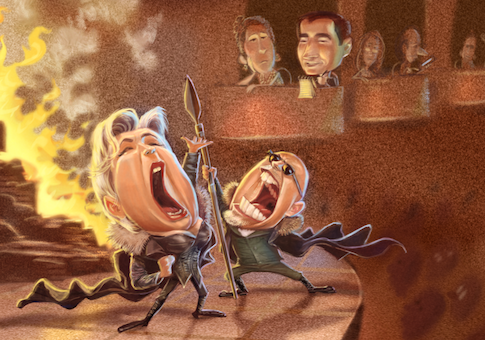Last year, I had the good fortune to travel to Neuschwanstein Castle in Germany, a place that illustrates Richard Wagner’s kingly stature in that country. The castle was built between 1869 and 1886 by an actual king, Bavaria’s Ludwig II, to honor Wagner and his work. It is perched on a mountainside overlooking miles of verdant farmland, looking like it was ripped from a fairy tale—so much so that Disney based Sleeping Beauty’s castle off of it. The rooms are even more explicitly fantastic, dedicated to mythic figures like Tristan and Isolde, Tännhauser, and Lohengrin.
"[T]he location is one of the most beautiful to be found, holy and unapproachable," Ludwig wrote to the artist, "a worthy temple for the divine friend who has brought salvation and true blessing to the world." That is a strong endorsement, whether or not Ludwig was insane as his ministers had him declared in 1886. Clearly the king’s life was transformed by exposure to Wagner’s art. He remained a patron for many years, financing the artist’s operas and the impressive space designed to stage them at Bayreuth.
If you read Wagner’s essays, it is clear that nothing short of transformation—of the individual, of society—was his goal as an artist. Wagner wrote that the highest art that had ever been produced were the tragedies of the Greeks, which unified all the parts of art into a whole. For the Greeks, drama "was a religious festival, where the gods bestirred themselves upon the stage and bestowed on men their wisdom."
"This flower was the highest work of Art, its scent the spirit of Greece," Wagner wrote in characteristically earnest and overheated prose, "and still it intoxicates our senses and forces from us the avowal, that it were better to be for half a day a Greek in presence of this tragic Art-work, than to all eternity an—un-Greek God!" In Wagner’s telling, this true art was chopped up and debased by the forces of reaction in subsequent generations as fame-hungry artists responded to wealthy patrons who wanted to be amused and flattered at the theater, not challenged.
Wagner proposed to bring art back. Not the way it was; he would do it better. Art "cannot be re-born," he wrote, "but must be born anew."
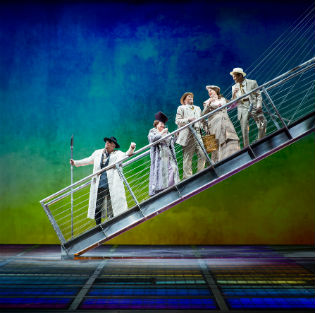
The Ring of the Nibelung was one product of that Herculean effort, an opera in three parts plus a prologue that took almost 30 years to complete and takes almost 20 hours to stage, including intermissions. The Ring Cycle, as it is called, follows a cast of gods, heroes, and beasts as they struggle for control of a golden ring that is said to give its bearer immense power. The narrative arc mirrors Wagner’s account of art history, tracing a society’s calamitous fall from a golden age and hinting at a possible better future. The gold that was used to forge the ring is stolen from a riverbed at the beginning of The Rhinegold, a theft that throws the ideal world of Act I, Scene I into chaos. The natural order crumbles over the course of four operas, culminating with The Twilight of the Gods, when the warrior-princess Brünnhilde sacrifices herself to melt down the ring, ushering in a new age run not by the avaricious, failed gods of old but by chastened and hopeful men. The other ten hours of the cycle fill in the details: there are rainbow bridges, golden apples, underground cities, incestuous lovers, rocks encircled by enchanted fire, dragons, Wagner tubas. It is all rather hard to explain.
Boy is it significant, though. The Ring Cycle is so fundamental to opera that many of the art form’s stereotypes in popular culture originate from it: The Viking helmet craze stems from the Norse-inspired costumes of the Ring’s original cast; the sports phrase "it ain’t over ‘til the fat lady sings" is a jaunty reference to Brünnhilde’s death song. The Ring Cycle even has its own Bugs Bunny cartoon, for reasons known only to Warner Brothers Studio. In other words, the Ring Cycle is the major leagues. When all four of its operas are unified it is always a big to-do, drawing Wagner Heads, all the little Ludwigs of our day, from the far reaches of the earth.
I was not a Wagner Head. Before this point, my exposure to opera had been entirely of the peppy Italian variety—you go in, Figaro Figaro, you go out. But when I heard that the Kennedy Center was staging the cycle, I decided to experience the gesamkunstwerk, Wagner’s term for the all-consuming artwork he thought could change the world, for myself. Would it transform me? Would Wagner be my "divine friend" too after sitting in a room with him for 20 hours?
As it turns out, attending a Ring Cycle is like attending any major festival—a Burning Man or Coachella—except the low is traded for the high, the weed for the wine, the young for the old, the bead-fringed T-shirts of wolves for evening gowns and penguin suits. Browsing the playbill, I found interviews with cast members and seasoned Wagner hands advising greenhorns how to prepare for their first rodeo. All of their comments touched on the cycle’s stupendous length. "Remember that Wagner-time is different from Verdi-time," advised the mezzo-soprano Elizabeth Bishop (Fricka). "Embrace that you have nowhere else to be for these hours," said one Andrew Jorgensen.
The festive atmosphere was not confined to the auditorium. In the atrium before the show, a pair of alphorn players tooted a regal, Teutonic tune for the gathered throngs. During intermissions theatergoers ate boxed lunches of sandwiches and chips, the Kennedy Center having acted on Mark Twain’s suggestion that if you attend a Wagner season, "bring your dinner-pail with you. If you do, you will never cease to be thankful." I saw an elderly couple in evening dress sitting cross-legged on the ground like they might have done at Woodstock, contentedly attending to their meals. As I did not preorder a box, I hydrated and walked slow laps around the Kennedy Center to keep up energy. This was a marathon, not a sprint.
My seatmate was an older gentleman with a wispy, professorial air who was reviewing the performance for a New York arts publication. He was a veteran of many campaigns. This, he informed me, was his fifth cycle and one of the best. The worst had gone overboard on spectacle by making use of puppets so that the various characters could appear on stage in multiple places at once. Such was the director’s hubris. I learned that and more in the intervening periods just before the lights dimmed, the crowd hushed, and the music swelled at the gentle direction of the white-haired conductor, Philippe Auguin.
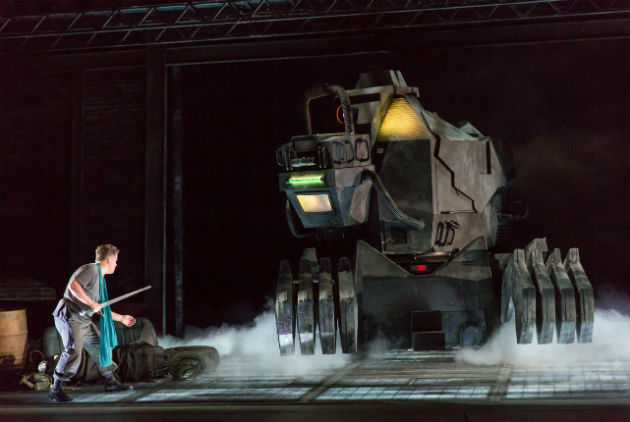
The overture to each act in a Wagner opera is typically played to a dark hall with the curtain down so the audience is prepared for the coming attraction in a reverent, unisensory environment. "It was exquisite; it was delicious," Twain said of this effect when he visited Bayreuth. Try it at home, reader: close your eyes and listen to The Valkyrie prelude to Act I. Sense the storm, the rolling thunder, the hunted man crashing through the forest. This is peak Wagner you are sensing.
Not leaving well enough alone, the Kennedy Ring Cycle projected videos onto the curtain during these overtures. The videos varied in obtrusiveness, from simple projections of riverbeds like the screensavers on an old Windows system to shaky footage of forests. A case could be made that the videos prepared the audience for the show by progressing with the story and anticipating the setting of each act. But then again so did the music, which was evocative enough that it should have been left alone, unyoked to distracting gimmicks.
The videos were not just eye candy. Mostly they served as a vehicle for the production’s message about environmentalism. As the playbill states, "Wagner offers in The Ring a vision of a looming man-made natural catastrophe that might bring about worldwide destruction." If you didn’t get the hint from that or the essay asking if Wagner would today be "a rabble-rouser for Greenpeace," video projections of oil refineries shimmering in the heat clued you in. Likewise, the production progressed from the Edenic meadows and rivers of Rhinegold to the garbage-strewn, acid-blasted heath of Twilight of the Gods, which was traversed by Norns in sickly green biohazard suits.
This cycle was also billed as an American Ring, dreamt up by an American, Francesa Zambello, who incorporated bits of Americana into the production’s framework. The American influence was present in several striking tableaus. The overall-wearing giants Fafner and Fasold were lowered onto the stage on a steel girder after building Valhalla for the gods—dead-ringers for the construction workers who lunched nonchalantly on the bones of the Empire State Building. The Valkyries, dressed as World War II aviators, parachuted onto the ruins of a German pillbox. The dead heroes the Valkyries brought to Valhalla were military ID photos of U.S. servicemembers killed in Iraq and Afghanistan. At the end, as Valhalla crumbled, these photos fluttered to the ground like the blizzard of ash and paper that fell to the streets of New York City during an awful götterdämmerung in our recent history.
There was a lot to like there, and Zambello made a theme that could have felt forced seem natural. The quintessential Wagnerian aesthetic was never overwhelmed by the American. But there was an undercurrent to the opera that jarred: especially in Rhinegold, Zambello emphasized a divide between gods and non-gods. The god Wotan was depicted as a vainglorious titan of industry in spectator shoes and a cream-colored suit to accompany his customary spear and eyepatch; his brother-in-laws were feckless scions in prep school jackets. These elites were contrasted with the laborer-giants and the wretched Nibelungs, who worked in sweatshop conditions, driven by a cruel master.
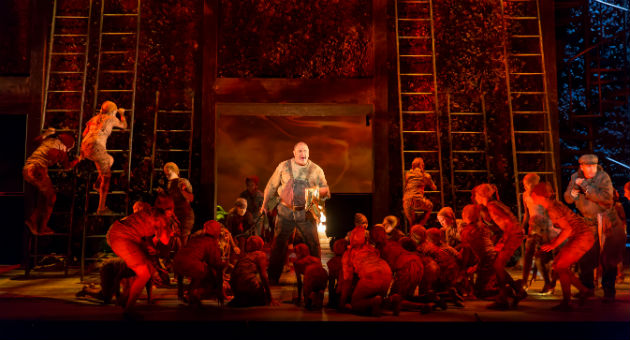
The class commentary here was obvious. Like the environmental theme, it would have been understandable had it stood on its own—Wagner, after all, had socialist sympathies and participated in Dresden’s May Uprising. However, the class theme did not stand on its own: it was paired with the environmental theme’s warnings against oil, plastics, and other consumer goods—precisely the things that enabled laborers in our country and around the world to rise out of abject poverty. The disconnect between these themes was best shown in Siegfried where a scene took place under an overpass, a concrete blight on the natural world that is nonetheless a symbol of opportunity for the American middle class.
But enough of that. There was much that was beautiful, even transformative, here. The orchestra was guided with a gentle hand by Auguin, who turned up the heat only when it really counted, like during Siegfried’s Funeral March. The cast was strong, especially in supporting roles like the jealous goddess Fricka (Bishop), treacherous dwarf Mime (David Cangelosi), and boastful hunter Hunding (Raymond Aceto). Special mention goes to William Burden (Loge), who played the mischievous fire god with a slickness and dynamism in The Rhinegold that made me miss his character in the next three operas.
The sets were masterpieces of light and color that used technology to spectacular effect (including, this grump must concede, the use of video projections). The final set of Rhinegold required nothing but a drawbridge to admit the gods into Valhalla, but LED floor panels and a video projection cast a heavenly rainbow light over the proceeding. It was the perfect tone for that act, as the gods enjoyed one last untroubled moment before their dominion collapsed around their ears. The later sets were also otherworldly, using zones of light and shadow to depict the universe at twilight—their stark, supernatural beauty reminded me of the landscapes of Félix Vallotton.
As other, more notable reviewers have commented, there are excruciating moments in Wagner. The last act of Siegfried, while it clocks in at an unremarkable 75 minutes, seems to last an eternity because it is composed almost entirely of the hero-lovers Siegfried and Brünnhilde striking poses on a rock and admiring each other. These were the times when this writer’s eyes began to droop, when his zeal for gesamkunstwerk began to flag, when he tried to seance with the hovering spirit of Richard Wagner and tell him to WRAP IT UP ALREADY, RICK.
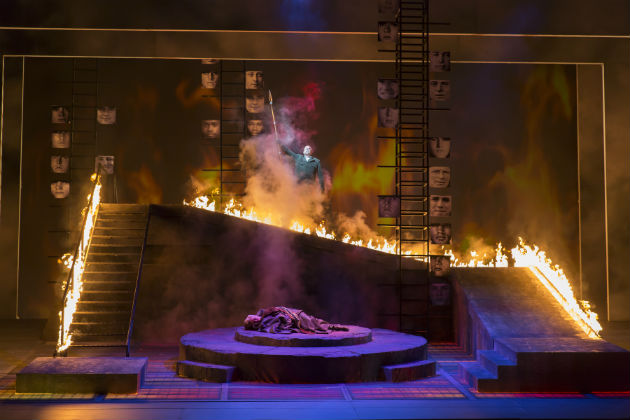
More often I was rapt at attention, as when Wotan encircled a sleeping Brünnhilde in a roaring fire at the end of Valkyrie. If Wagner’s goal was to unify all the components of artwork into a whole, there are moments—overwhelming moments—during the Ring Cycle when you think he might have pulled it off.
Was I a changed man upon emerging from the theater that final time? No, I was not. The effect was burning on a slower fuse than that. First I had to process what I had seen and identify what was so appealing about the production. Eventually I came to a partial answer that led me back to the beginning of my inquiry: The Ring Cycle was appealing precisely because it was the effort of a great artist to change the lives of his audience members through art alone. Wagner and his horned helmets are easy to ridicule, but then again so are all artists who work without the arch smile and irony so common today. The Ring Cycle was not intended to entertain you, it was intended to evangelize you. If the result wasn’t revolutionary, if the audience was not converted, at least it caught glimpses of the intended vision.
As I resumed my normal routine in the days that followed, the production followed me. I caught myself humming the Wagnerian jingles known as leitmotifs. I kept listening to music from the cycle to drown out ambient noise at the office while editing—slashing the red pencil to the blare of the brass and boom of the timpani. If I was not a Wagner Head, I at least had Wagner stuck in my head. And I would see the Ring Cycle again if given the chance, all 20 hours of it.
